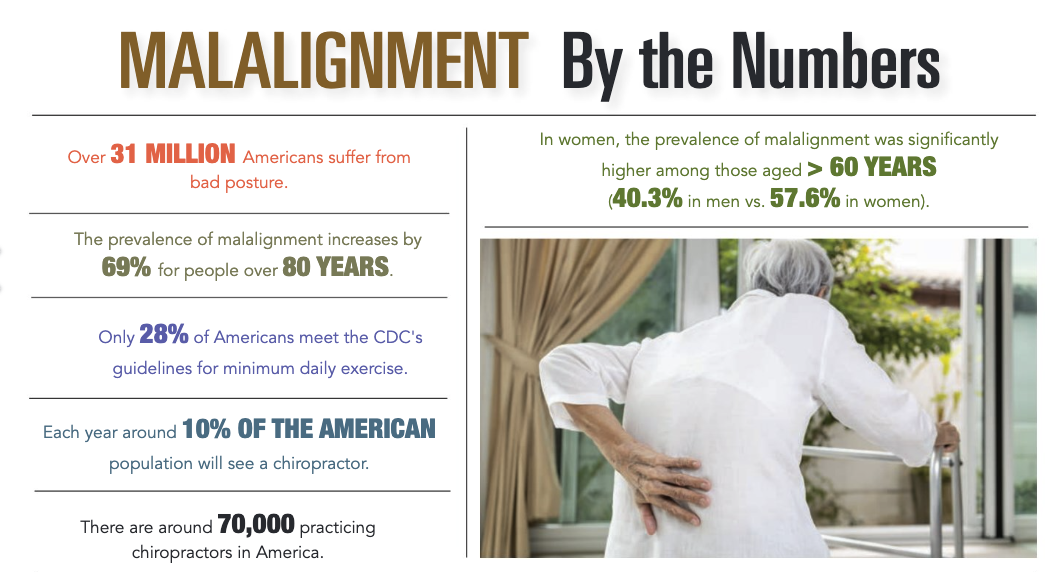Back pain has become a silent epidemic that transcends age, occupation and lifestyle.
According to health experts, poor back alignment is a major contributor to this pervasive issue.
With many jobs tethering individuals to desks and screens for prolonged periods, the spine is increasingly subject to unnatural postures. Hunched shoulders, forward head tilt and slouched backs have become all too common, contributing to chronic pain and musculoskeletal issues, explained Dr. Matt Murrin, fitness and lifestyle consultant, physiologist, chiropractor and owner of Chiropractic USA in Mount Pleasant.
“The human body is designed for movement and one of the primary culprits disrupting our alignment is the sedentary nature of many people’s lives today,” he added.
The increased use of cell phones, whether it’s for social media, texting or work purposes — even iPads used to entertain and educate kids — contribute to a specific condition called forward head posture, or FHP.
“Symptoms of FHP include the neck slanting forward and the head pokes in front of your shoulders instead of resting directly about them,” explained Dr. Sarah Kalani Wharton, chiropractor and owner of Cypress Chiropractic & Wellness in Charleston.
This position can strain neck muscles and place extra pounds of pressure on the cervical spine, which increases the risk of spinal regeneration, she added.
Physical changes in a person’s posture offer an alert that it is time to seek advice and treatment from chiropractors, a primary care physician and/or a physical therapist; however, quite often someone’s back can be misaligned without any obvious symptoms for a long time.
“By the time symptoms appear, the problem has probably been festering for so long that discomfort begins because the nervous system has met its threshold,” Dr. Wharton explained. “The spine and the nervous system are essentially a highway from the brain to the body. Misalignment puts pressure on the nervous system until obvious symptoms appear.”
Symptoms of misalignment may include brain fog, tight muscles, fatigue, anxiety and a sense that typical posture is “off.”
While the challenges of contemporary living are evident, it is not all doom and gloom. In addition to seeking professional help, people can be proactive by making lifestyle changes.
Raising your phone to eye level when you text, raising your computer screen at your desk, using a standing desk and focusing on keeping your posture upright are all examples of proactive lifestyle changes, according to Dr. Murrin.
The right pillow matters too.
“You want to make sure your pillow is supportive and the correct fit for the size of your head,” Murrin added. “If the pillow is too big, it pushes your head too far forward, which exacerbates forward head posture. A pillow that is too thin can be harmful as well, causing your muscles to work too hard at night while sleeping when it’s supposed to be relaxing.”
Murrin and others also recommend postural strengthening exercises.
Adjusting back alignment is an ongoing venture; it’s not a one adjustment and done condition.
“Think about going to the gym,” explained Dr. Lee Russo, chiropractor, clinical director and owner of Axis Chiropractic Care in Charleston. “To reach a goal or alleviate a problem, one workout at the gym is not enough.”
Sometimes the solution involves changing daily habits too, Russo adds. “Certain habits — like someone’s sleeping position — can contribute to alignment issues.”
Whether you are hunched over a desk or bending to tie your shoes, back alignment plays a critical role in your daily comfort and mobility. There is no one-size-fits-all solution, experts noted. But a combination of professional care and proactive, preventative measures should ease that achy, breaky feeling that accompanies misalignment.
Signs You Have Poor Posture
There are many indicators of poor posture, but some of the more common are hunched shoulders, rounded shoulders, rounded upper back, forward head carriage and arched lower back. Another indicator is back pain. Unsure if you have good posture? Talk to your chiropractor or schedule an appointment for a spinal examination.
Factors that Contribute to Poor Posture
There are several common factors linked to poor posture:
- Stress
- Obesity
- Pregnancy
- Weak postural muscles
- Abnormally tight muscles
- High-heeled shoes
How to Maintain or Correct Posture
The first step is awareness! Bring your attention to your posture as you sit, stand or lie down. If you’re sitting, keep both feet on the floor or a footrest, don’t cross your legs and use low-back support. While standing, keep your knees slightly bent, relax your arms and pull your shoulders back. When lying down it’s critical to choose the right mattress and pillow, and to avoid sleeping on your stomach.
Source: chiropracticusasc.com/posture-chiropractor
By Lisa Moody Breslin








